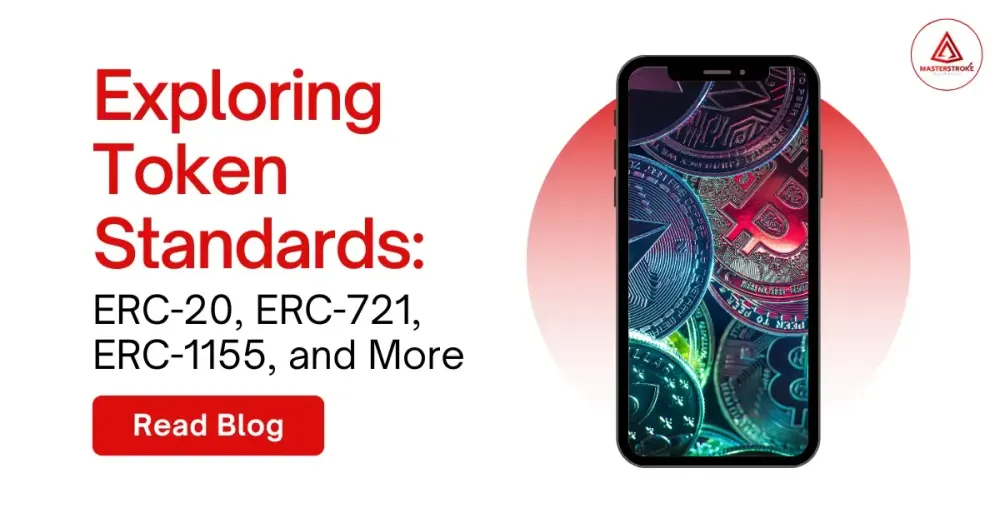A Comprehensive Guide to Token Standards: ERC-20, ERC-721, ERC-1155, and Beyond
 Masterstroke Technosoft
Masterstroke Technosoft
When you hear people talk about cryptocurrencies or NFTs, chances are you'll come across terms like ERC-20, ERC-721, or even ERC-1155. These aren't just random codes or tech jargon; they represent the backbone of how digital assets operate on the Ethereum blockchain. Understanding these token standards is essential if you're diving into the world of Web3, whether you're an investor, developer, or just a curious explorer.
Let’s explore these token standards in depth — what they are, why they’re important, and how they differ.
What is a Token Standard?
Before jumping into specific token standards, it's helpful to understand what a token standard actually is. In the world of Ethereum, token standards are essentially rules or blueprints for creating and managing tokens. These standards make sure that all tokens created under them follow a consistent structure. Think of it as a common language that all applications and wallets can understand.
Token standards allow for interoperability. For example, a token following the ERC-20 standard can be easily listed on decentralized exchanges, stored in wallets, or integrated into dApps without requiring any custom code.
ERC-20: The Standard for Fungible Tokens
What is ERC-20?
ERC-20 is the most widely adopted token standard on Ethereum. It defines a set of functions that a token contract must implement, such as transfer, balanceOf, and approve. These functions allow for the basic management of token balances and the ability to send tokens from one user to another.
ERC-20 tokens are fungible, meaning each token is exactly the same in value and function as another. Think of it like dollars or Bitcoin. One token equals one token, no matter who owns it.
Popular Use Cases
- Stablecoins
- Utility tokens
- Governance tokens
Pros
- Widely supported across wallets and exchanges
- Simple and easy to implement
- Large developer community and tooling support
Cons
- Not suitable for unique items or digital collectibles
- Lacks advanced features like batch transfers
ERC-721: The Birth of NFTs
What is ERC-721?
ERC-721 introduced a new type of token: the non-fungible token (NFT). Unlike ERC-20 tokens, each ERC-721 token is unique and can carry its own metadata and properties. This standard is perfect for representing ownership of digital assets that are one-of-a-kind, such as art, music, or virtual real estate.
Each token has a unique ID, and the metadata associated with it can point to an image, description, or even ownership history.
Popular Use Cases
- Digital art
- Virtual real estate
- Gaming items
Pros
- Enables true digital ownership
- Supports rich metadata and uniqueness
- Growing ecosystem with marketplaces like OpenSea
Cons
- Higher transaction costs due to complexity
- No built-in support for batch transfers or grouped assets
ERC-1155: The Best of Both Worlds
What is ERC-1155?
ERC-1155 is a multi-token standard that combines the best aspects of ERC-20 and ERC-721. Created by Enjin, this standard allows for both fungible and non-fungible tokens to exist in a single smart contract.
This makes it incredibly efficient, especially for gaming and digital collectibles, where you may have both types of assets. For example, a game might use ERC-1155 to issue fungible in-game currency and unique weapons, all managed under one contract.
Popular Use Cases
- Gaming platforms
- Batch token transfers
- Multi-asset wallets
Pros
- Supports batch transfers, reducing gas fees
- Combines fungibility and uniqueness
- Ideal for complex ecosystems like games
Cons
- More complex to implement
- Not as widely adopted yet compared to ERC-20 and ERC-721
Beyond Ethereum: Other Token Standards
Ethereum isn't the only game in town. Other blockchains have their own token standards that aim to solve similar problems or offer unique advantages.
Binance Smart Chain (BSC)
- BEP-20: Similar to ERC-20
- BEP-721 and BEP-1155: Counterparts to Ethereum's NFT standards
Solana
- Uses its own program-based architecture rather than strict standards
- More focused on performance and low transaction fees
Tezos, Flow, and Others
- Offer unique smart contract languages and standards tailored to their ecosystems
These alternative standards are gaining traction, especially as issues like Ethereum's gas fees continue to pose challenges.
The Future of Token Standards
As the blockchain space evolves, so too will token standards. We're seeing growing interest in:
- Soulbound tokens (SBTs): Non-transferable tokens representing credentials or achievements
- Modular standards: Allowing optional extensions for tokens
- Interoperability protocols: Ensuring tokens can move seamlessly across chains
Developers are pushing the boundaries to make tokens more versatile, secure, and user-friendly.
Final Thoughts
Token standards like ERC-20, ERC-721, and ERC-1155 form the foundation of today's digital asset ecosystem. They provide a common language for developers and ensure that tokens behave predictably across platforms. Whether you're collecting NFTs, investing in crypto, or building a new dApp, understanding these standards gives you a crucial edge.
As the Web3 space grows, so will the need for new and improved standards. The more we understand these blueprints, the better we can innovate, invest, and participate in this exciting new digital frontier.